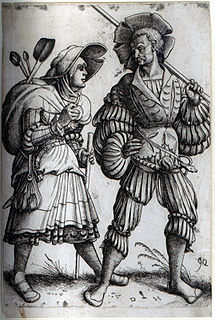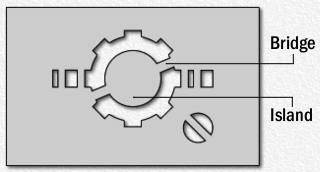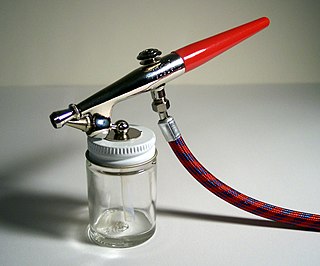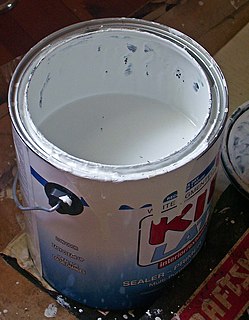This article needs additional citations for verification .(February 2015) |

A frisket is any material that protects areas of a work from unintended change. [1]
This article needs additional citations for verification .(February 2015) |

A frisket is any material that protects areas of a work from unintended change. [1]
On a sheet-fed letterpress printing machine, a frisket is a sheet of oiled paper that covers the space between the type or cuts (illustrations) and the edge of the paper that is to be printed. When the press operator uses a brayer to coat the surface of the type with ink, the ink brayer will often coat the furniture and slugs (wood and metal spacers) between the columns and around the type. To keep this ink from touching the target sheet, the frisket covers the area that is not desired to print. The frisket is set in a frame, often hinged to the tympan that holds the paper in place. [2]
A new frisket has to be cut for each different page or form; a well-made frisket lasts for hundreds or thousands of impressions.
In airbrushing, a frisket is a plastic sheet with an adhesive backing used to mask off specific areas of an image so that only the exposed area is covered with paint. The frisket is vital to airbrushing, because it allows the artist to control excess paint spray, create special effects, achieve extreme precision, control edge attributes and expedite the airbrushing process. [3]
A frisket differs from other masks in that it is a single sheet that covers the entire work, parts of which are removed by cutting into the sheet. Friskets are available in matté and glossy finishes. Some friskets are also solvent-proof, manufactured for use with solvent-reduced and -based urethanes.
The frisket is fixed to the painting surface and then the appropriate shapes are cut out of the material using a razor or scalpel. The cut piece is lifted, the exposed area painted, and the process repeated using the cut pieces to mask their matching finished areas. When all painting is finished, the resulting work contains precise shapes with no overspray.
In watercolor painting, frisket, also sometimes called masking fluid, is a removable liquid masking fluid based on latex and ammonia, often available in various colours to make its presence more obvious, which is applied to the surface in order to mask off the areas that are not to be coloured by a given application of paint. Frisket is usually used when the unmasked areas are desired to be the same colour and a rapid wash is being applied, or for negative painting effects.
Watercolouring frisket is applied using a brush, allowed to dry, and then the watercolour paints are applied and also allowed to dry. Once the paper is completely dry, the frisket can be easily removed by gentle rubbing with a natural crepe rubber pickup, the same as those used for removal of rubber cement. The paper must be completely dry before removing the frisket as the friction can otherwise damage the paper if still damp.
A subsequent application of frisket can be applied to mask other areas—usually those with the intention of applying a different colour or to darken some areas whilst not affecting others—and removed with the natural rubber pickup. This process can be repeated several times without damaging artist-grade watercolour papers, so long as the paper is completely dry after each application of watercolours. Some lesser grades of paper, often used for practice and academic purposes, may be more prone to damage after repeated masking and painting cycles, however. Although watercolour frisket can be removed by rubbing with the fingers, doing so has the disadvantage of potentially transferring skin oils which can discolour the artwork, or otherwise affect subsequent applications of watercolours or other media such as chalk or ink.

Acrylic paint is a fast-drying paint made of pigment suspended in acrylic polymer emulsion and plasticizers, silicone oils, defoamers, stabilizers, or metal soaps. Most acrylic paints are water-based, but become water-resistant when dry. Depending on how much the paint is diluted with water, or modified with acrylic gels, mediums, or pastes, the finished acrylic painting can resemble a watercolor, a gouache, or an oil painting, or have its own unique characteristics not attainable with other media.

Paint is any pigmented liquid, liquefiable, or solid mastic composition that, after application to a substrate in a thin layer, converts to a solid film. It is most commonly used to protect, color, or provide texture. Paint can be made in many colors—and in many different types. Paint is typically stored, sold, and applied as a liquid, but most types dry into a solid. Most paints are either oil-based or water-based and each has distinct characteristics. For one, it is illegal in most municipalities to discard oil-based paint down household drains or sewers. Clean-up solvents are also different for water-based paint than they are for oil-based paint. Water-based paints and oil-based paints will cure differently based on the outside ambient temperature of the object being painted Usually, the object being painted must be over 10 °C (50 °F), although some manufacturers of external paints/primers claim they can be applied when temperatures are as low as 2 °C (35 °F).

Etching is traditionally the process of using strong acid or mordant to cut into the unprotected parts of a metal surface to create a design in intaglio (incised) in the metal. In modern manufacturing, other chemicals may be used on other types of material. As a method of printmaking, it is, along with engraving, the most important technique for old master prints, and remains in wide use today. In a number of modern variants such as microfabrication etching and photochemical milling it is a crucial technique in much modern technology, including circuit boards.

Printmaking is the process of creating artworks by printing, normally on paper, but also on fabric, wood, metal, and other surfaces. "Traditional printmaking" normally covers only the process of creating prints using a hand processed technique, rather than a photographic reproduction of a visual artwork which would be printed using an electronic machine ; however, there is some cross-over between traditional and digital printmaking, including risograph. Except in the case of monotyping, all printmaking processes have the capacity to produce identical multiples of the same artwork, which is called a print. Each print produced is considered an "original" work of art, and is correctly referred to as an "impression", not a "copy". However, impressions can vary considerably, whether intentionally or not. Master printmakers are technicians who are capable of printing identical "impressions" by hand. Historically, many printed images were created as a preparatory study, such as a drawing. A print that copies another work of art, especially a painting, is known as a "reproductive print".

Gouache, body color, or opaque watercolor, is a water-medium paint consisting of natural pigment, water, a binding agent, and sometimes additional inert material. Gouache is designed to be opaque. Gouache has a considerable history, having been used for at least twelve centuries. It is used most consistently by commercial artists for posters, illustrations, comics, and other design work.

Monotyping is a type of printmaking made by drawing or painting on a smooth, non-absorbent surface. The surface, or matrix, was historically a copper etching plate, but in contemporary work it can vary from zinc or glass to acrylic glass. The image is then transferred onto a paper by pressing the two together, using a printing-press, brayer, baren or by techniques such as rubbing with the back of a wooden spoon or the fingers which allow pressure to be controlled selectively. Monotypes can also be created by inking an entire surface and then, using brushes or rags, removing ink to create a subtractive image, e.g. creating lights from a field of opaque colour. The inks used may be oil or water-based. With oil-based inks, the paper may be dry, in which case the image has more contrast, or the paper may be damp, in which case the image has a 10 percent greater range of tones.

Watercolor or watercolour, also aquarelle, is a painting method in which the paints are made of pigments suspended in a water-based solution. Watercolor refers to both the medium and the resulting artwork. Aquarelles painted with water-soluble colored ink instead of modern water colors are called aquarellum atramento by experts. However, this term has now tended to pass out of use.

Stencilling produces an image or pattern by applying pigment to a surface under an intermediate object with designed gaps in it which create the pattern or image by only allowing the pigment to reach some parts of the surface. The stencil is both the resulting image or pattern and the intermediate object; the context in which stencil is used makes clear which meaning is intended. In practice, the (object) stencil is usually a thin sheet of material, such as paper, plastic, wood or metal, with letters or a design cut from it, used to produce the letters or design on an underlying surface by applying pigment through the cut-out holes in the material.

An airbrush is a small, air-operated tool that atomizes and sprays various media, most often paint but also ink and dye, and foundation. Spray painting developed from the airbrush and is considered to employ a type of airbrush.

In art, craft, and engineering, masking is the use of materials to protect areas from change, or to focus change on other areas. This can describe either the techniques and materials used to control the development of a work of art by protecting a desired area from change; or a phenomenon that causes a sensation to be concealed from conscious attention.

A permanent marker or indelible marker is a type of marker pen that is used to create permanent or semi-permanent writing on an object. In general, the ink comprises a main carrier solvent, a glyceride, a pyrrolidone, a resin and a colorant, making it water resistant. It is capable of writing on a variety of surfaces from paper to metal to stone. They come in a variety of tip sizes, shapes, and colors. Most markers have alcohol-based solvents. Other types, called paint markers, like spray paint, contain volatile organic compounds which evaporate to dry the ink. Due to compounds such as toluene and xylene often being present in permanent markers, they have a potential for abuse as a recreational drug.

Offset printing is a common printing technique in which the inked image is transferred from a plate to a rubber blanket and then to the printing surface. When used in combination with the lithographic process, which is based on the repulsion of oil and water, the offset technique employs a flat (planographic) image carrier. Ink rollers transfer ink to the image areas of the image carrier, while a water roller applies a water-based film to the non-image areas.

Photogravure is a process for printing photographs, also sometimes used for reproductive intaglio printmaking. It is a photo-mechanical process whereby a copper plate is grained and then coated with a light-sensitive gelatin tissue which had been exposed to a film positive, and then etched, resulting in a high quality intaglio plate that can reproduce detailed continuous tones of a photograph.

White spirit or mineral spirits, also known as mineral turpentine (AU/NZ), turpentine substitute, and petroleum spirits, is a petroleum-derived clear liquid used as a common organic solvent in painting. There are also terms for specific kinds of mineral spirits, including Stoddard solvent and solvent naphtha (petroleum). Mineral spirits are often used as a paint thinner, or as a component thereof, though paint thinner is a broader category of solvent. Odorless mineral spirits (OMS) have been refined to remove the more toxic aromatic compounds, and are recommended for applications such as oil painting.

Masking tape, also known as painter's tape, is a type of pressure-sensitive tape made of a thin and easy-to-tear paper, and an easily released pressure-sensitive adhesive. It is available in a variety of widths. It is used mainly in painting, to mask off areas that should not be painted.
A paint marker is a type of marker pen that is used to create permanent writing on a variety of surfaces such as paper, metal, stone, rubber, plastic, and glass.

A primer or undercoat is a preparatory coating put on materials before painting. Priming ensures better adhesion of paint to the surface, increases paint durability, and provides additional protection for the material being painted.

Hand-colouring refers to any method of manually adding colour to a monochrome photograph, generally either to heighten the realism of the image or for artistic purposes. Hand-colouring is also known as hand painting or overpainting.

Stone rubbing is the practice of creating an image of surface features of a stone on paper. The image records features such as natural textures, inscribed patterns or lettering. By rubbing hard rendering materials over the paper, pigment is deposited over protrusions and on edges; depressions remain unpigmented since the pliable paper moves away from the rendering material. Common rendering materials include rice paper, charcoal, wax, graphite or inksticks. Over time, the practice of stone rubbing can cause permanent damage to cultural monuments due to abrasion. For an artist, stone rubbings can become an entire body of creative work that is framed and displayed.

A wash is a term for a visual arts technique resulting in a semi-transparent layer of colour. A wash of diluted ink or watercolor paint applied in combination with drawing is called pen and wash, wash drawing, or ink and wash. Normally only one or two colours of wash are used; if more colours are used the result is likely to be classified as a full watercolor painting.